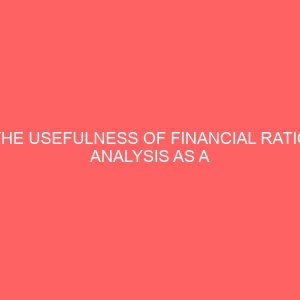Description
THE USEFULNESS OF FINANCIAL RATIO ANALYSIS AS A TOOL FOR ENHANCEMENT OF CORPORATE INVESTMENT DECISION
ABSTRACT
Most management of business enterprise are yet to come to teams of realities of the usefulness of financial ratios on their business overall achievement. Many think that financial ratio cannot be use as a tool in enhance of corporateunrestemnt decision and as such does not deserve consideration. The intention of the researcher is to bring to light the implication of this oversight and also expose managers and prospective shareholders to some financial ratio techniques. By this way the researcher tried to establish why financial ratios is essential on investment decision making. Equally, questionnaire are issued, administered to both employees and top management of transcorp limited in order to ascertain their views financial ratio as it relates to their company. The data collected were however analyzed using percentage and chi-square. Finally, recommendations were made to ensure reliability and accurate use of financial ratios. It is hoped tht this research work will be of immense help to future researcher on this topic.
Chapter One
INTRODUCTION
1.1 Background of the Study
Financial ratios are tools used to analyze financial conditions and performance. Financial analysis means different things to different people. Trade creditors are primarily interested in the liquidity of the firm being analyzed. Their claims are short-term and the ability of the firm to pay these can be judged by an analysis of its liquidity.
On the other hand, the claims of bond holders are long term. They are interested in the cash flow of the firm to service debts over a long period of time. The bond holders may evaluate this analyzing the capital structures of the firm the major sources and users of fund, the firm’s profitability.
Finally, an investor in a company’s common stock is concerned principally with present and expected future earning as well as the stability of these earning about a trend. As a result, the investor usually concentrates on analyzing the profitability of the firm (Financial ratios).
The point of view of the analyst may be either external or internal. For external, it involves suppliers of capital while that of internal, the firm needs to undertake financial analysis, firm financial position and evaluation opportunities in relation of their effects on this position. With internal control, the managers are particularly concerned with return on investment in the various assets of the company and in the efficiency of assets management.
Financial analysis involves the use of financial statement. These statement attempt to several things. They portray the assets and liabilities of a business firm at a moment in time usually at the end of the year. While balance sheet represents a snapshot of the firm’s statement of assets and liabilities at a moment in time, the income statement depicts its profitability over time.
1.2 Statement of the Problem
It has been shown that ratio analysis on its own does not always automatically rectify statement nor is the only parameter used in management decision making nor is it sufficient for interpreting company’s accounts. The study therefore, is faced with the problem of determining the extent to which financial ratio can assist management of any organization in interpreting company’s account and the extent to which management uses them in the decision making.
1.3 Objectives of the Study
The main aim of this study is to assess the usefulness of financial ratio analysis as a tool for enhancement of corporate investment decision
Other Sub-Objectives Include:-
1. To ascertain whether the financial ratio enhance investment decision
2. To ascertain whether the financial ratio is an indicator of corporate health.
3. To assess the role of financial ratio in predicting the flow of investment from investors
1.4 Research Questions
1) Does the use of financial ratios enhance investment decision?
2) Is financial ratio an indicator of corporate health?
3) Does the role of financial ratio predict the flow of investment from investors?
1.5 Research Hypothesis
This creates focus on the line of enquiring andproviding checkpoint against which interviewed questionnaires were compiled. Therefore, for the purpose of analyzing the response obtained from respondent, the researcher had formulated the following hypothesis.
Hypothesis I
Ho: The use of financial ratio does not enhance investment decision.
Hi: The use of financial ratio enhance investment decision.
Hypothesis II
Ho: financial ratio is not an indicator of corporate health.
Hi: Financial ratio is an indicator of corporate health.
Hypothesis III
Ho: Financial ratio does not predict the flow of investment from investors
Hi: Financial ratio predicts the flow of investment form investors.
1.6 Significance of the Study
The benefit of an effective application of financial ratio analysis of business organization cannot be overemphasized. This is because the study when complex and with consequent recommendation will go a long way in assisting the policy makers of various organization. Both the study, however, would be of immense benefits to the shareholders of transcorp, government investors, financial house or institutions, long-term and short term creditors, students, the general public at large and to further researchers on the subject who will need the work as a reference material in their research.
1.7 Scope and Limitations of the Study
This research work is meant to carry out on the usefulness of financial ratio analysis as a tool for enhancement of corporate investment decision with Transcorp Limited Enugu Branch as a case study. Considering, the researcher goes beyond desk, researcher into the analysis of financial statement of transcorp Limited from 1989 to 1993 to interpret, amplify and translate the fact and data contained into eh financial statement, the purpose being drawing of relevant conclusion, therefore, making inference as the business operations, financial position and future prospect which involves analysis of data contained in financial statement into certain basic component.
1.8 Definition of Terms
Financial Statement: This consists of balance sheet, profit and loss account or income statement, the note on the accounts, sources and application of funds statement value added statement and historical financial summary.
Profit and Loss Account: This is the record of business transaction of a company for a given period of time usually one year.
Asset: Economic resources owned by a business, which are expected to future operations.
Liabilities: These are debts or obligation of a business organization, the claims of creditors against the asset of a business e.g Creditor, bank overdraft.
Balance Sheet: This is a statement of the assets and liabilities of a company on a given day.
Ratio Analysis: This involves company on figure against another to produce a ratio and assessing whether the ratio indicate weakness or strength in the company’s affairs.
Current Assets: This includes cash temporary short-term investment that could be quickly sold for cash and those assets directly involved in the entity operating system or cycle.
Current Liabilities: Current asset minus current liabilities equals to working capital or to be more precise, net working capital.
Dividend: Distribution of profit by corporation to different shareholders, directors and stakeholders to the company. Liquidity will result in bad credit ratings and loss of confidence by creditors. It is necessary on balance between liquidity and lack of liquidity.
Current Ratio: This equals to Current Assets
Current liabilities
This is a measure of liquidity of solvency. Ozoani G. c. (1998) states that current ratio measure the extent to which claims to short-term creditors are covered by short-term assets. And it is determined by dividing current assets by current liabilities.
Quick or Acid Test Ratio: This test is also known as “quick ratio”, because it is assumed to include the assets most quickly convertible into cash. Ozoani G. C. (1998) also states that the quick acid text is calculated by deducting inventories from current asset and dividing the remainder by current liabilities. Inventories are typically the least liquid of a firm’s current assets and the assets on which losses are most likely to occur in the event of liquidation. Therefore, this is a measure of the firm’s ability to pay off short term obligations without relying on the sale of inventories.
Current Assets – Inventory
Quick ratio or Acid Test Current Liabilities
Inventory Turnover Ratio: This equals to:
Sales
Inventory
Sales cost of goods sold. The inventory turnover ratio measure the average rate of speed with which inventories moves through and out of the enterprises. It also indicates the velocity at which the trading stock is being sold or turnover.







Reviews
There are no reviews yet.